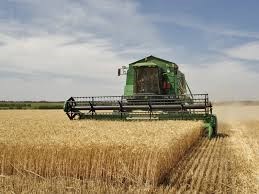Good harvest progress was made this week thanks to relatively warm and dry weather conditions. Ninety-three per cent of the crop is now combined. This is just behind the five-year (2009-2013) average of 96 per cent. Harvest is most advanced in Crop District 3ASE (Radville and Oungre fall in this area) where 99 per cent of the crop is combined. Ninety-eight per cent is combined in 2A (Weyburn area) and 93 per cent in 1B (Stoughton area). Some producers are wrapping up harvest efforts while others will need at least another week of warm and dry weather to complete harvest.
Topsoil moisture conditions on cropland are rated as 20 per cent surplus, 77 per cent adequate and three per cent short. Hay land and pasture moisture is rated as 14 per cent surplus, 77 per cent adequate and nine per cent short. Topsoil moisture conditions have improved over the last couple of weeks, although some fields are still too wet to access and there are many deep ruts from stuck equipment.
Although the 2014 harvest is coming to an end, it is only the beginning of the long process of cleaning and marketing grain, something that will be more problematic for this year’s crop due to numerous quality issues.
The wet spring and summer allowed many diseases to proliferate and cause damage to a multitude of cereals throughout the southeast this year. In particular, fusarium head blight, mildew and sprouting are among the top issues affecting grains.
“Every now and then you get an off year, and 2014 just happened to be that year. It’s going to be a tough crop to move, but if producers have good samples it will move. It always does,” said Roy Hoffart of Parrish and Heimbecker.
According to Hoffart, many of the cereals that have arrived at the Parrish and Heimbecker terminal have been afflicted by fusarium head blight, and in some cases the amount contained in samples is as high as 10 per cent. The Canadian Grain Commission permits only small amounts of fusarium infected kernels into food and feed quality grains to account for mycotoxins that are produced by fusarium head blight. These toxins can be potentially harmful to humans and livestock.
“Right now, we’re busy trying to clean up the grain and get fusarium infected crops, particularly durum, down to two parts per million of vomitoxin. It can be quite a difficult task,” added Hoffart.
In addition, sprouting and bleaching have caused further damage to many spring wheat crops, resulting in downgrading.
In an interview on Monday morning, Cedoux area producer Dale Paslawski added that the 2014 harvest was challenging and somewhat of a disappointment after the exceptional harvests of the last two years.
“The wet weather really wreaked a lot of havoc for producers. It caused a lot of downgrading to crops, and cereals and pulses were hit the hardest. In my area there are some producers who will be leaving their pulses in the field,” said Paslawski.
Paslawski noted that producers that grew durum may find themselves in a more favourable position, adding that prices for the cereal have skyrocketed, with even low quality durum fetching a high price. However, many durum producers have seen their fair share of struggles this year.
“North of Cedoux, fusarium and other diseases absolutely decimated durum crops, there weren’t even heads left on them.
It’s not unexpected though. The moisture provided the perfect opportunity diseases to spread, and producers just haven’t been rotating their crops like they should be. Instead of growing a crop once every two or three years, producers are growing the same crop year after year, and if dozens of producers are growing the same crop in close proximity to their neighbours, then it’s no surprise that these crop diseases caused so much damage. We’ve built up a disease bank and it’s really starting to bite producers now,” added Paslawski.




